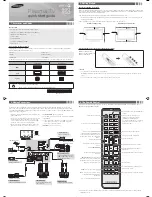
Service Modes, Error Codes, and Fault Finding
5.
5.5
Error Codes
5.5.1
Introduction
The error code buffer contains all detected errors since the last
time the buffer was erased. The buffer is written from left to
right, new errors are logged at the left side, and all other errors
shift one position to the right.
When an error has occurred, the error is added to the list of
errors, provided the list is not full or the error is a protection
error.
When an error occurs and the error buffer is full, then the new
error is not added, and the error buffer stays intact (history is
maintained), except when the error is a protection error.
To prevent that an occasional error stays in the list forever, the
error is removed from the list after 50+ operation hours.
When multiple errors occur (errors occurred within a short time
span), there is a high probability that there is some relation
between them.
5.5.2
How to read the Error Buffer
Use one of the following methods:
•
On screen via the SAM (only if you have a picture).
Examples:
–
0 0 0 0 0
: No errors detected
–
6 0 0 0 0
: Error code 6 is the last and only detected
error
–
9 6 0 0 0
: Error code 6 was first detected and error code
9 is the last detected error
•
Via the blinking LED procedure (when you have no
picture). See next paragraph.
•
Via ComPair.
5.5.3
How to clear the Error Buffer
Use one of the following methods:
•
By activation of the “RESET ERROR BUFFER” command
in the SAM menu.
•
With a normal RC, key in sequence “MUTE” followed by
“062599”
and “OK”.
•
When you transmit the commands “DIAGNOSE” - “99” -
“OK” with ComPair (or with a DST).
•
If the content of the error buffer has not changed for 50+
hours, it resets automatically.
5.5.4
Error Codes
In case of non-intermittent faults, clear the error buffer before
you begin the repair. This to ensure that old error codes are no
longer present. Before clearing the buffer, write down the
content, as this history can give you significant information.
If possible, check the entire contents of the error buffer. In
some situations, an error code is only the result of another error
code and not the actual cause (e.g., a fault in the protection
detection circuitry can also lead to a protection).
There are various errors:
•
I
2
C device errors.
•
I
2
C bus errors.
•
Protection errors.
•
Errors not related to an I
2
C device, but of importance:
–
FEM (Falconic with Embedded Memory) (Error 26):
at start-up, after initialisation of the PICNIC, the
presence of the FEM can be checked.
Table 5-3 Error Code Overview
Note
:
•
Error codes 1, 6, or 18 are protection codes and in this
case, supplies of some circuits will be switched “off”. Also,
in protection, the LED will blink the number of times
equivalent to the most recent error code.
Error Device
Description
Def. item
Def. Module indication Diagr.
1
M24Cxx
NVM, spontaneous blinking error 1
7011
-
B5a
3
SAA4978
PICNIC
7713
Feature Box
B3a
4
Supply 5 V
5V protection
-
+5V Supply
B5a
5
Supply 8 V
8V protection
-
+8V Supply
B5a
6
Slow I
2
C bus blocked
Spontaneous blinking error 6
-
Slow I
2
C Blocked
-
8
TDA932x
HIP High-end Input Processor
7323
Chroma IF IO
B2
13
UV1318/...
Tuner protection
1T01
Tuner
B13a
14
MSPxxxx
ITT sound processor
7A02
Audio module
B6a
18
Fast I
2
C bus blocked
Spontaneous blinking error 18
-
Fast I
2
C Blocked
-
21
M62320
I/O Expander
7P56
Video Dual Screen
B15b
26
SAA4998
FEM (Falconic with Embedded Memory)
7760
+3V (FBX) Supply
B3b
27
T6TX5
Eagle 1C
7720
+3V (FBX) Supply
B3c
32
M29W400xx
Flash Ram (EPG)
7012
EPG Memory
B5a
35
T6TU5
Columbus
7752
Video Control
B3d
55
DC/DC converter
One of the voltages is not ok + protection error
-
MSB
-
76
Audio supply
Audio supply protection
-
-
-
118
AD9883A
AD converter
7L01
HD
B19a
121
EPLD
EPLD error
7V01
Video control
B19d
Note:
If error 3 or error 55 appears, sometimes error 16 is also logged. Error 16 is a non existing error.
















































